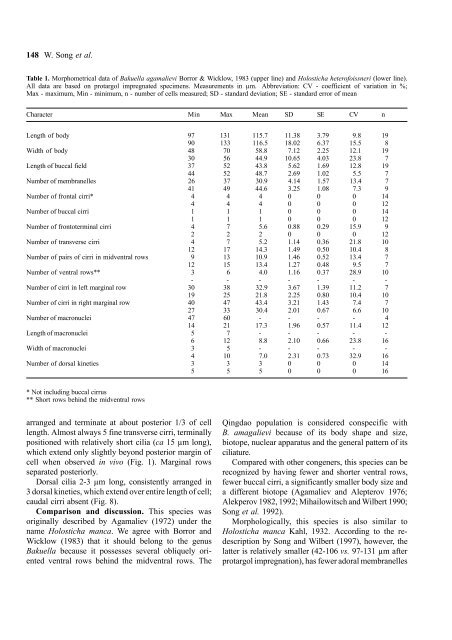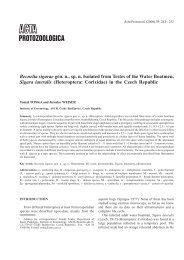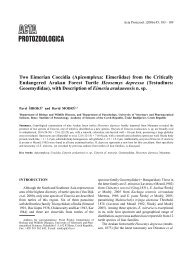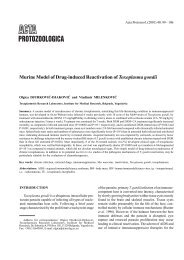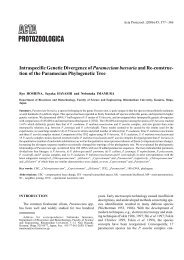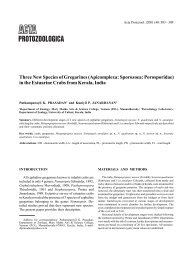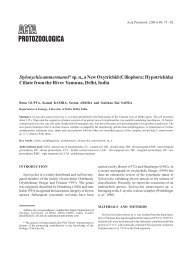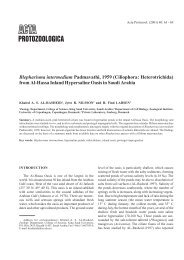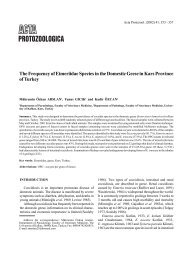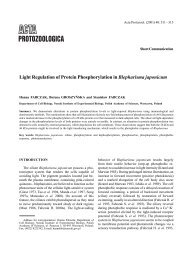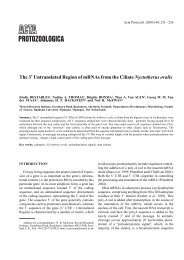New Contribution to the Morphology and Taxonomy of Four Marine ...
New Contribution to the Morphology and Taxonomy of Four Marine ...
New Contribution to the Morphology and Taxonomy of Four Marine ...
You also want an ePaper? Increase the reach of your titles
YUMPU automatically turns print PDFs into web optimized ePapers that Google loves.
148 W. Song et al.<br />
Table 1. Morphometrical data <strong>of</strong> Bakuella agamalievi Borror & Wicklow, 1983 (upper line) <strong>and</strong> Holosticha heter<strong>of</strong>oissneri (lower line).<br />
All data are based on protargol impregnated specimens. Measurements in µm. Abbreviation: CV - coefficient <strong>of</strong> variation in %;<br />
Max - maximum, Min - minimum, n - number <strong>of</strong> cells measured; SD - st<strong>and</strong>ard deviation; SE - st<strong>and</strong>ard error <strong>of</strong> mean<br />
Character Min Max Mean SD SE CV n<br />
Length <strong>of</strong> body 97 131 115.7 11.38 3.79 9.8 19<br />
90 133 116.5 18.02 6.37 15.5 8<br />
Width <strong>of</strong> body 48 70 58.8 7.12 2.25 12.1 19<br />
30 56 44.9 10.65 4.03 23.8 7<br />
Length <strong>of</strong> buccal field 37 52 43.8 5.62 1.69 12.8 19<br />
44 52 48.7 2.69 1.02 5.5 7<br />
Number <strong>of</strong> membranelles 26 37 30.9 4.14 1.57 13.4 7<br />
41 49 44.6 3.25 1.08 7.3 9<br />
Number <strong>of</strong> frontal cirri* 4 4 4 0 0 0 14<br />
4 4 4 0 0 0 12<br />
Number <strong>of</strong> buccal cirri 1 1 1 0 0 0 14<br />
1 1 1 0 0 0 12<br />
Number <strong>of</strong> fron<strong>to</strong>terminal cirri 4 7 5.6 0.88 0.29 15.9 9<br />
2 2 2 0 0 0 12<br />
Number <strong>of</strong> transverse cirri 4 7 5.2 1.14 0.36 21.8 10<br />
12 17 14.3 1.49 0.50 10.4 8<br />
Number <strong>of</strong> pairs <strong>of</strong> cirri in midventral rows 9 13 10.9 1.46 0.52 13.4 7<br />
12 15 13.4 1.27 0.48 9.5 7<br />
Number <strong>of</strong> ventral rows** 3 6 4.0 1.16 0.37 28.9 10<br />
- - - - - - -<br />
Number <strong>of</strong> cirri in left marginal row 30 38 32.9 3.67 1.39 11.2 7<br />
19 25 21.8 2.25 0.80 10.4 10<br />
Number <strong>of</strong> cirri in right marginal row 40 47 43.4 3.21 1.43 7.4 7<br />
27 33 30.4 2.01 0.67 6.6 10<br />
Number <strong>of</strong> macronuclei 47 60 - - - - 4<br />
14 21 17.3 1.96 0.57 11.4 12<br />
Length <strong>of</strong> macronuclei 5 7 - - - - -<br />
6 12 8.8 2.10 0.66 23.8 16<br />
Width <strong>of</strong> macronuclei 3 5 - - - - -<br />
4 10 7.0 2.31 0.73 32.9 16<br />
Number <strong>of</strong> dorsal kineties 3 3 3 0 0 0 14<br />
5 5 5 0 0 0 16<br />
* Not including buccal cirrus<br />
** Short rows behind <strong>the</strong> midventral rows<br />
arranged <strong>and</strong> terminate at about posterior 1/3 <strong>of</strong> cell<br />
length. Almost always 5 fine transverse cirri, terminally<br />
positioned with relatively short cilia (ca 15 µm long),<br />
which extend only slightly beyond posterior margin <strong>of</strong><br />
cell when observed in vivo (Fig. 1). Marginal rows<br />
separated posteriorly.<br />
Dorsal cilia 2-3 µm long, consistently arranged in<br />
3 dorsal kineties, which extend over entire length <strong>of</strong> cell;<br />
caudal cirri absent (Fig. 8).<br />
Comparison <strong>and</strong> discussion. This species was<br />
originally described by Agamaliev (1972) under <strong>the</strong><br />
name Holosticha manca. We agree with Borror <strong>and</strong><br />
Wicklow (1983) that it should belong <strong>to</strong> <strong>the</strong> genus<br />
Bakuella because it possesses several obliquely oriented<br />
ventral rows behind <strong>the</strong> midventral rows. The<br />
Qingdao population is considered conspecific with<br />
B. amagalievi because <strong>of</strong> its body shape <strong>and</strong> size,<br />
bio<strong>to</strong>pe, nuclear apparatus <strong>and</strong> <strong>the</strong> general pattern <strong>of</strong> its<br />
ciliature.<br />
Compared with o<strong>the</strong>r congeners, this species can be<br />
recognized by having fewer <strong>and</strong> shorter ventral rows,<br />
fewer buccal cirri, a significantly smaller body size <strong>and</strong><br />
a different bio<strong>to</strong>pe (Agamaliev <strong>and</strong> Alepterov 1976;<br />
Alekperov 1982, 1992; Mihailowitsch <strong>and</strong> Wilbert 1990;<br />
Song et al. 1992).<br />
Morphologically, this species is also similar <strong>to</strong><br />
Holosticha manca Kahl, 1932. According <strong>to</strong> <strong>the</strong> redescription<br />
by Song <strong>and</strong> Wilbert (1997), however, <strong>the</strong><br />
latter is relatively smaller (42-106 vs. 97-131 µm after<br />
protargol impregnation), has fewer adoral membranelles


